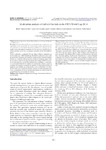Mostrar o rexistro simple do ítem
Multivariate analysis of indirect free kick in the FIFA World Cup 2014
| dc.contributor.author | Ardá Suárez, Antonio | |
| dc.contributor.author | Maneiro, Rubén | |
| dc.contributor.author | Losada, J.L. | |
| dc.contributor.author | Casal Sanjurjo, Claudio Alberto | |
| dc.date.accessioned | 2024-04-17T08:32:17Z | |
| dc.date.available | 2024-04-17T08:32:17Z | |
| dc.date.issued | 2017-10 | |
| dc.identifier.citation | Maneiro, R., Losada López, J. L., Casal Sanjurjo, C. A., & Ardá Suárez, A. (2017). Multivariate analysis of indirect free kick in the FIFA World Cup 2014. Anales de Psicología, 2017, vol. 33, num. 3, p. 461-470. | es_ES |
| dc.identifier.issn | 0212-9728. | |
| dc.identifier.uri | http://hdl.handle.net/2183/36234 | |
| dc.description.abstract | [Resumen] Los tiros libres indirectos son situaciones que se producen con regularidad durante los partidos de fútbol, siendo acciones potencialmente trascendentales en el resultado final de los partidos. Los objetivos de este estudio fueron determinar la efectividad de estas acciones, identificar las va-riables asociadas con el éxito y proponer un modelo de tiro libre indirecto exitoso. Fueron codificados y analizados 506 tiros libres indirectos registrados en los 64 partidos de la FIFA World Cup Brasil 2014, se llevaron a cabo análi-sis univariados, bivariados (Ji-Cuadrado) y multivariados (regresión logística binaria), los resultados indican una baja eficacia en el remate, remate entre los tres palos y el gol en este tipo de acciones. En cambio, el 89% de los go-les con procedencia en un tiro libre indirecto han contribuido a sumar pun-tos en el resultado final de los partidos. La organización ofensiva, basada en maniobras de creación y ocupación de espacios, y la intervención de hasta 4 jugadores, son variables que se han revelado como moduladoras de la efica-cia. Sin duda, estos enunciados podrían suponer un punto de partida para dotar a entrenadores de nuevas herramientas tácticas con el fin de dotar de un perfil más eficaz en este tipo de acciones. | es_ES |
| dc.description.abstract | [Abstract] Indirect free kicks are relatively common in soccer and have the potential to change the outcome of a match. The aim of this study was to determine the effectiveness of these kicks, to identify variables associated with success, and propose a model for optimal execution. We analyzed and coded 506 indirect free kicks taken in 64 matches during the FIFA 2014 World Cup in Brazil and conducted univariate, bivariate (chi-square), and multivariate (binary logistic regression) analyses. Our re-sults show very low success rates in terms of shots, shots between the posts, and goals. Nevertheless, 89% of goals scored from indirect free kicks led to the teams gaining valuable points. Determinants of success included a dynamic attack based on the creation and occupation of spaces and the intervention of up to four attackers. Our findings offer an interesting start-ing point for trainers to build on tactical strategies designed to improve free-kick performance. | es_ES |
| dc.description.sponsorship | We gratefully acknowledge the support of both Spanish government projects: Avances metodológicos y tecnológicos en el estudio observacional del comportamiento deportivo (Secretaría de Estado de Investigación, Desarrollo e Innovación del Ministerio de Economía y Competitividad) during the period 2015-2017 [Grant PSI2015-71947-REDT; MINECO/FEDER, UE], and La actividad física y el deporte como potenciadores del estilo de vida saludable: Evaluación del comportamiento deportivo desde metodologías no intrusivas (Secretaría de Estado de Investigación, Desarrollo e Innovación del Ministerio de Economía y Competitividad) during the period 2016-2018 [Grant DEP2015-66069-P; MINECO/FEDER, UE]. We gratefully acknowledge the support of the Generalitat de Catalunya Research Group (GRUP DE RECERCA E INNOVACIÓ EN DISSENYS [GRID]). Tecnología i aplicació multimedia i digital als dissenys observacionals], [Grant 2014 SGR 971] | es_ES |
| dc.description.sponsorship | Generalitat de Catalunya; 2014 SGR 971 | |
| dc.language.iso | eng | es_ES |
| dc.publisher | Universidad de Murcia | es_ES |
| dc.relation | info:eu-repo/grantAgreement/MINECO/Plan Estatal de Investigación Científica y Técnica y de Innovación 2013-2016/PSI2015-71947-REDT/ES/AVANCES METODOLOGICOS Y TECNOLOGICOS EN EL ESTUDIO OBSERVACIONAL DEL COMPORTAMIENTO DEPORTIVO | es_ES |
| dc.relation | info:eu-repo/grantAgreement/MINECO/Plan Estatal de Investigación Científica y Técnica y de Innovación 2013-2016/DEP2015-66069-P/ES/LA ACTIVIDAD FISICA Y EL DEPORTE COMO POTENCIADORES DEL ESTILO DE VIDA SALUDABLE: EVALUACION DEL COMPORTAMIENTO DEPORTIVOS DESDE METODOLOGIAS NO INTRUSIVAS | es_ES |
| dc.relation.uri | https://doi.org/10.6018/analesps.33.3.271031 | es_ES |
| dc.rights | Atribución-NoComercial-SinDerivadas 4.0 Internacional | es_ES |
| dc.rights.uri | https://creativecommons.org/licenses/by-nc-nd/4.0/deed.es | * |
| dc.subject | Regresión logística | es_ES |
| dc.subject | Metodología observacional | es_ES |
| dc.subject | Fútbol | es_ES |
| dc.subject | Saque de esquina | es_ES |
| dc.subject | Logistic Regression | es_ES |
| dc.subject | Observational methodology | es_ES |
| dc.subject | Soccer | es_ES |
| dc.subject | Corner. | es_ES |
| dc.title | Multivariate analysis of indirect free kick in the FIFA World Cup 2014 | es_ES |
| dc.type | info:eu-repo/semantics/article | es_ES |
| dc.rights.access | info:eu-repo/semantics/openAccess | es_ES |
| UDC.journalTitle | Anales de Psicología | es_ES |
| UDC.volume | 33 | es_ES |
| UDC.issue | 3 | es_ES |
| UDC.startPage | 461 | es_ES |
| UDC.endPage | 470 | es_ES |
| dc.identifier.doi | 10.6018/analesps.33.3.271031 |
Ficheiros no ítem
Este ítem aparece na(s) seguinte(s) colección(s)
-
GI-PHG - Artigos [118]






